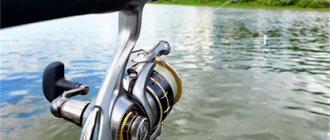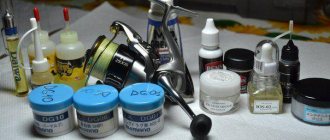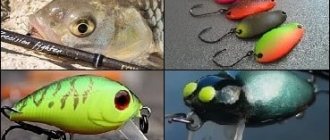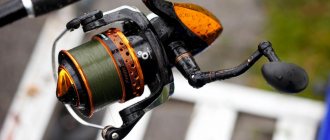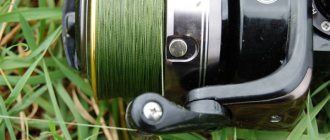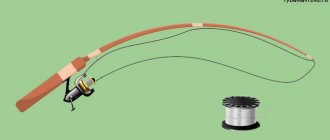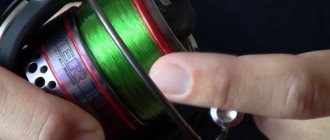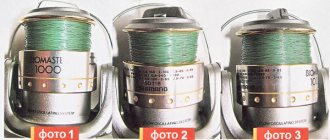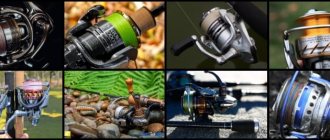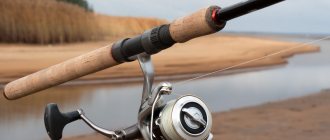How often should you lubricate your reel?
The main element of the mechanism is a chain of star-shaped wheels, which set the remaining parts in motion. During the operation of the fishing rod, sand and dirt become clogged between the teeth of the gears. This is not noticeable unless you disassemble the spinning reel. At first, the presence of foreign bodies does not affect fishing in any way. But over time, this leads to corrosion of metal parts. To prevent the problem, you must inspect and clean the coil regularly.
The mechanism must be lubricated in the following cases:
- at the beginning of the season;
- with frequent fishing;
- when the reel is in contact with water or sand for a long time.
Inspection and cleaning are required after every fishing trip. With regular periodic maintenance, the device will last a long time.
Care and prevention of breakdowns
In the manufacture of premium models, such as Shimano, Daiwa, etc., a number of rules are observed that ordinary fishermen do not even think about. With minor interference in the mechanism, extraneous noise appears. Therefore, you only need to disassemble the spinning reel if performance deteriorates.
Read: Daiwa Freams Series Reels
Representatives of the “standard” and “economy” classes more calmly tolerate interference from fishermen. Some cheap brands with an anti-reverse system require replacing the thick lubricant in the overrunning clutch with liquid lubricant immediately after purchase. But it’s better to fish with the new device at least once and then disassemble it.
Most fishermen maintain the mechanism themselves and do not experience any major difficulties. To be sure, before lubricating the spinning reel, you can not neglect modern technologies and take photographs, gradually disassembling the nuts and gears. When assembling, it will be more difficult to mix up the order of parts. But there are also companies that provide professional technical maintenance.
How to lubricate spinning reels
Manufacturers produce many lubricants specifically for fishing rods. All of them are divided into 3 large groups:
- for gears and bearings - a thick mass that prevents foreign bodies from sticking to the mechanism;
- for shafts and rotors - a liquid product that flows over the working elements, but does not leak due to the hermetically sealed housing;
- universal - lubricants in the form of a medium-thick mass or spray, suitable for all parts.
You can lubricate the spinning reel with grease or machine oil. But it is difficult to say how these substances interact with the materials from which the mechanism is made. WD-40 is harmless to most types of plastics. But this is a means for immediate results. For example, it is needed to open a jammed lock. It is not advisable to lubricate the fishing device with WD-40, since it is not designed for a long-term effect.
It is better to use professional preparations. It is not advisable to mix lubricants from different companies. If you don’t find the product from the right company, you can lubricate the spinning reel with another one. But first you need to remove the remaining proprietary lubricant from the reel. In the absence of special equipment, many fishermen recommend rubbing bearings with Ciatim-203, and rotors and shafts with sewing machine oil.
Read: Correct hooking, landing and catching fish in the landing net
Secrets of successful fishing: Reel care
Reel care,
In order for the coil to work properly, you need to take care of it accordingly and handle it carefully. To do this, try to follow the following rules. The reel is sensitive to shock and requires lubrication. It should always be transported in rigid packaging. After fishing, shake off the reel and dry it a little. If it becomes significantly dirty, thoroughly clean it and lubricate it. Never place the reel on the ground, as clay and sand getting into the bearings will damage them. Caring for the reel in this way will significantly increase its service life. If you have to remove the drum right on the shore, it is better to disassemble the reel over a cap, cap or handkerchief, so as not to lose the screws and washers. After reassembling it, do not forget to adjust the brake again.
The coil is less likely to be damaged
than a fishing rod, but gets dirty more. Therefore, it must first be painstakingly cleaned of dust and contaminated lubricant, and then the axle and bushing hole must be wiped dry. carefully examine and lubricate all parts subject to friction with petroleum jelly (not boron) or some other long-lasting lubricant that does not drain from the axle and does not interfere with the rotation of the drum due to its thickness and ductility. The reel should be stored in a case.
USEFUL TIPS
Reel Care
— so that in a reel for fishing with an artificial fly the cord does not get between the drum and the body, you need to reduce the gap between them. To do this, a narrow layer of cork or a narrow strip of another material is glued around the circumference of the inside of the case with water-repellent glue. Particular attention should be paid to the spring brake, which, when unwinding, prevents the very fast rotation of the drum and tangles the cord.
Reel Care
- the free drum is not completely filled with new fishing line. The remaining supply is used for winding old, but high-quality (good) fishing line, tied to the newest one. The end of the fishing line that does not fit onto the drum is cut off. Then they remove the full drum from the reel and insert a spare one, onto which they rewind the line from the first one. As a result, the old line will be at the bottom, and the new line will be at the top. If there is no spare drum, they find a free place and wind up the entire fishing line, and then rewind it again from the other end. To prevent it from slipping off the drum, they tighten it (over the fishing line) with an elastic band.
Rings
A good ring is one that is made of hard material, light, strong and well polished. The highest hardness and smoothness of the rings ensure low friction, thereby increasing the service life of the line, the ring itself and casting distance. The quality of the ring is determined by the strength of the material from which it is made, lightness, good polishing and the height of the stand.
Rack height
The stand should be quite high so that the line does not stick to the rod. The strength and polishing of the rings. The strength and polishing of the rings help to minimize friction during the passage of the fishing line, which ensures the required casting distance and extends the service life of the fishing line and the ring itself. The strength of the material from which the rings are made is especially important when fishing for large fish, when a significant load falls on the rings.
Regardless of material, guide rings
must always be perfectly polished. The higher their wear resistance, the easier it is to maintain them in this condition. For example, on ordinary clay rings, a noticeable roughness that needs to be eliminated appears after about 20 fishing trips; rings based on high-quality aluminum oxide can withstand at least a season without additional polishing. “FUJI SIC” or “GOLD CERMET” rings, even with the most active fishing, require polishing no more than once every two to three years.
USEFUL INFORMATION
Reel Care
— iron rings develop grooves on the inner surface during operation. The best so far are agate, shiny iron or carbide-chrome alloy, porcelain and quartzite rings. Caring for the reel - to reduce line friction, the first guide ring is made huge, then, towards the tip, the diameter of the rings is evenly miniaturized. Reel care - even the highest quality guides do not completely protect against line breakage. Therefore, the angler must make fuller use of the elastic characteristics of the fishing rod. If it has a good structure, then with an angle between the stretched line and the rod of 90-110°, you can take out a large fish and save the tackle. The angle must not be sharp. And then, with the passage rings, the upper elbow may break off.
Placement and number of rings on the rod
It is very important to correctly position the guide rings on the rod. Having installed the reel on the rod, you need to look in the direction of the first ring: the longitudinal axis of the reel should pass through its middle. If this line deviates too much, the line will wind over the edge of the spool at an angle, causing enormous and uneven winding resistance.
Necessary ADVICE
Reel Care
— increased attention should be paid to the quality of “tulip” production.
The rigid insert in the “tulip” should protect the stand and plastic gasket from the scaffolding. Caring for the reel
- the rings not only guide the fishing line through themselves, but also relieve the load on the rod.
It would seem that the more rings, the better. But the extra rings add weight to the luxurious form. Therefore, you need to install as many rings as will be sufficient for normal unloading of the fishing rod in extreme operating conditions. Caring for the reel
- the number of rings on the rod does not have strict standards. This is a purely personal question and depends on many reasons. Each angler, based on the features of the form, decides for himself. Keep in mind that this is just a starting point for finding the best guide to rod length ratio for your specific situation.
USEFUL TIPS
Match rings have a huge advantage
- they are lighter than ordinary ones, so they can be installed one or two more, while maintaining the performance characteristics of a naked form. On the rod under the multiplier, the rings should be placed on the side opposite the seam. You also need to keep in mind that the fishing line passes from above and under critical loads will touch the whip if there are not enough rings.
Manufacturers of fishing equipment offer models of fishing rods
, which do not require rings. The line runs inside the rod itself over a perfectly polished Kevlar coating. Rods without guides are superior in strength to conventional fishing rods because they allow the load to be distributed more moderately. But the casting range in such rods is significantly less, so rods without guide rings are mainly used for fishing with a float rod, when the bait must be positioned no further than 15 m.
Reel lubrication steps
The whole process can be divided into 3 stages: disassembly, cleaning and lubrication, assembly. But first you need to prepare everything for work. If you are not sure of the positive outcome of independent intervention, then you can watch a video on disassembling a spinning reel or contact a specialist.
Preparation
To carry out this work, the table is cleared. Tools and materials are placed on it:
- screwdriver;
- adjustable wrench;
- a cotton swab and a soft brush;
- a glass of solvent (gasoline, ether or alcohol);
- lubricant;
- microfiber cloth;
- paper for folding parts;
- a means for flushing the coil from old grease (if necessary).
Lubricating a spinning reel with your own hands involves thorough wiping before disassembling. Stubborn dirt is removed with a cotton swab or soft brush dipped in ether, alcohol or lighter gasoline. This must be done to prevent foreign particles from getting into the open mechanism.
Lubrication technology
The main attention should be paid to processing the main gear pair. Make sure that the substance is distributed evenly on the surface. To do this, it is better to rotate the gear several times. This must be done right before installation. When installing, do not forget about the marks - it is important that the gears align perfectly without the slightest error. After this, the coil body is closed with a lid.
The laying machine bearing should also not be ignored. During fishing, it becomes clogged more often than any other element of the reel. This means it requires lubrication more often. For devices where it is closed on one side - each fisherman lubricates as needed, in a completely closed bearing - factory lubricant is included and no other is required.
Important! The final stage of lubrication is the treatment of the hinges of the arch, which are located on the rotor at the bottom of the line roller.
It is also recommended to periodically clean and lubricate the clutch. But for this it is better to purchase a separate type of product.
A budget option is rosin, which is used to rub the surface of the friction clutch after cleaning the elements. An alternative is to buy a waterproof lubricant with a thick consistency.
How to disassemble a spinning reel with a rear drag
Procedure:
- Unscrew the handle if it is removable.
- Unscrew the nut of the transmission device and remove the spool.
- Remove the stopper located under the spool.
- Pull out the rotor.
- Unscrew the nut that holds the line guide and remove it.
- Remove the side cover on the housing.
All parts are placed on the newspaper in the order in which they were removed. After the completed operations, only the slider and 2 gears will remain in the reel. They should only be removed if they are heavily soiled.
Cleaning and Lubrication
All removed elements are thoroughly washed with warm water, removing foreign substances. Stubborn dirt and old grease are cleaned with a cotton swab dipped in alcohol, lighter gasoline or ether. Particular attention is paid to bearings, in which sand most often accumulates. After washing, dry each part with a cloth or hairdryer.
Read: Choosing a reel for fishing from a boat
Having decided which lubricant is best to lubricate the spinning reel, perform this procedure. The product is applied with a cotton swab. It is distributed over all surfaces in small quantities. If there is excess lubricant, the spinning rod will not work better, and all the sand that gets into the body will stick to the working parts.
This is especially true for inertial coils. After removing the drum cover, the axle is exposed, which needs lubrication. If too much product has been applied, close the lid and, after turning the line guide, remove it again. Excess lubricant will remain on the gear. They are removed with a special solvent and the coil is put back together.
Fishing
To prevent fishing from turning into a hassle, I advise you, in addition to the main one, to take a spare reel with you. Before you start using it, run the reel at idle speed, adjust it, tighten it where necessary so that it does not let you down on the first cast. If you hear a crunching, squealing sound, the coil is jammed or the bearing hisses, put it in the case and grab a spare one. If this is not possible, spread a rag or newspaper on the ground (the main thing is that it is clean - no sand, no dirt) and carry out a simple technical inspection. The reasons for the “abnormal behavior” of the coil can be different. If the weather is too cold, the lubricant has thickened and the movement becomes too tight, just drip fresh lubricant from a tube or syringe. The same can be done with a slightly squeaking bearing of the line laying unit if water from a wet fishing line has gotten into it, but first you need to remove the spool and quickly rotate the reel forward, then the water will fan out along with the old lubricant. It's another matter if you dropped the reel into the water. Do not rotate the handle under any circumstances, otherwise dirt from the water will get into the bearing. Trying to check whether everything is in order with the reel in this case is perhaps the most common mistake made by spinners. Fish with another reel, and when you get home, disassemble this one, shake out the water, remove the grease, dry with a rag or hairdryer, rinse the bearing in purified gasoline, reassemble everything and add new grease. High-end reels are expensive, and such careful care will pay for itself, because this way you prolong its working condition. If you drop the reel in the sand, try to pick it up without turning it over so that it does not fall inside, and fan it with a grass broom. Remove the spool and check for sand stuck around the rotor rod. If yes, it is better to stop using the coil, otherwise sand will be drawn into the rotor and get on the gears. At home, you should disassemble it and wipe it thoroughly. But the likelihood that sand will get inside is not as great as that of water - the design of the coils, if possible, protects their mechanism from this nuisance. The most vulnerable components of a spinning reel The line roller sometimes makes uncharacteristic sounds when the reel is operating. In this case, lubricant should be dripped into the gaps (Fig. 15). The return spring of the line laying mechanism often fails. You can’t buy it, but it’s not difficult to make it yourself using pliers, round nose pliers and side cutters made of stainless steel hardened wire, but I recommend the diameter to be 0.1 millimeters smaller - then the spring will work softer (Fig. 16). As a last resort when fishing, you can make a spring from a safety pin.
15. Lubricating the line roller.
16. Spare return spring of the line handle.
The handle at the place where it is attached to the body becomes loose, a backlash appears, which is best eliminated immediately. To do this, you need to have a set of adjusting washers, with the help of which the backlashes are “selected”. Good reels always have washers at the end of the bearing for precise adjustment of the gearing. Plastic bushings under the main gear are usually installed in relatively inexpensive reels (in expensive ones there is a bearing). They wear out quickly, so it is recommended to stock up on more wear-resistant bushings (Fig. 17), for example Teflon.
17. Spare main gear support bushings.
There are situations when it is better to fish with a reel with bushings rather than with bearings - for example, in muddy water, where there is a lot of sand, which can quickly damage the reel. The bushings are not afraid of sand, since they tightly cover the support journals.
How to lubricate a spinning reel without disassembling
There are no videos or articles on the Internet about how to lubricate a spinning reel without disassembling it. This is because it is impossible to properly service the mechanism as a whole. It is important not just to lubricate the parts, but to evaluate their condition, clean, rinse, and dry. Only then will the lubricant have an effect and the device will last a long time.
A spray can be used as a temporary measure. You need to make sure that its interaction with the lubricant in the coil does not harm the parts. Compatibility information can be found on the spray packaging. But this does not relieve the fisherman from the need to disassemble and lubricate the device.
Just watch a video on lubricating a spinning reel to learn how to disassemble and maintain this device yourself. It is necessary to regularly inspect and clean the mechanism so that fishing is enjoyable and not a problem.
Types of lubricants
Available in different compositions:
- mineral,
- synthetic plastic,
- silicone and others.
The choice depends on the device and the material of the coil itself.
In addition, high-quality lubricant must meet a number of requirements:
- Be resistant to moisture and temperature changes.
- The ingredients must be compatible with metal and plastic based materials.
- Absence of any smell. Otherwise, it will scare away the fish.
- Water indelible.
- Ease of rotation of sealed bearings and other components.
Although mineral products are inexpensive, they have more disadvantages than advantages:
- thicken when cold,
- have a destructive effect on plastic,
- flows from the details
- has an unpleasant odor.
There are many lubricant options on sale, but the EFELE brand lubricant is considered the best.
Often, for use at home, fishermen also take ordinary machine oil or grease. But it’s definitely not possible to achieve high-quality care and extend service life using these substances.
Important! It is better to purchase lubricant from the same manufacturer as the reel. An alternative is to buy a universal one, which is great for both metal and plastic.
Based on consistency, there are two types of lubricant:
- Thick. Used to lubricate gears and bearings.
- Liquid. She will be able to lubricate the rotor and coil shaft.
To achieve the optimal effect and the substance does not leak out or impede the movement of the mechanism, thick lubricant is mixed with liquid lubricant.
Universal products also include the product of the EFELE brand. Made on the basis of polyalphaolefin, lithium soap. Any type of reel can be lubricated. Made in the form of a neat dispenser. It tolerates temperature changes from –50 to +120 degrees without changing consistency. Has no smell. Moisture resistant.
Therefore, when thinking about the question of how to lubricate a spinning reel, you should pay attention to this product. It is enough for repeated use, and thanks to its convenient packaging, it will not take up much space in a fishing suitcase.
